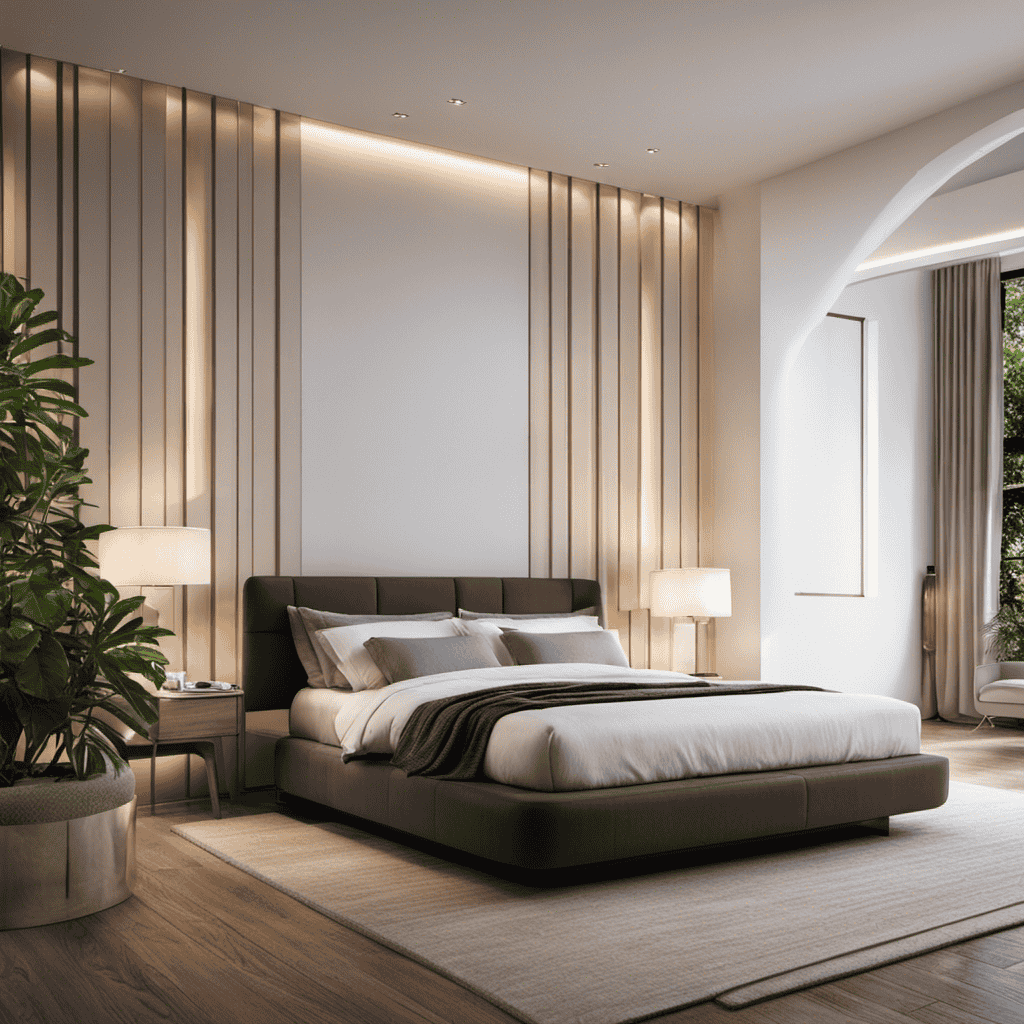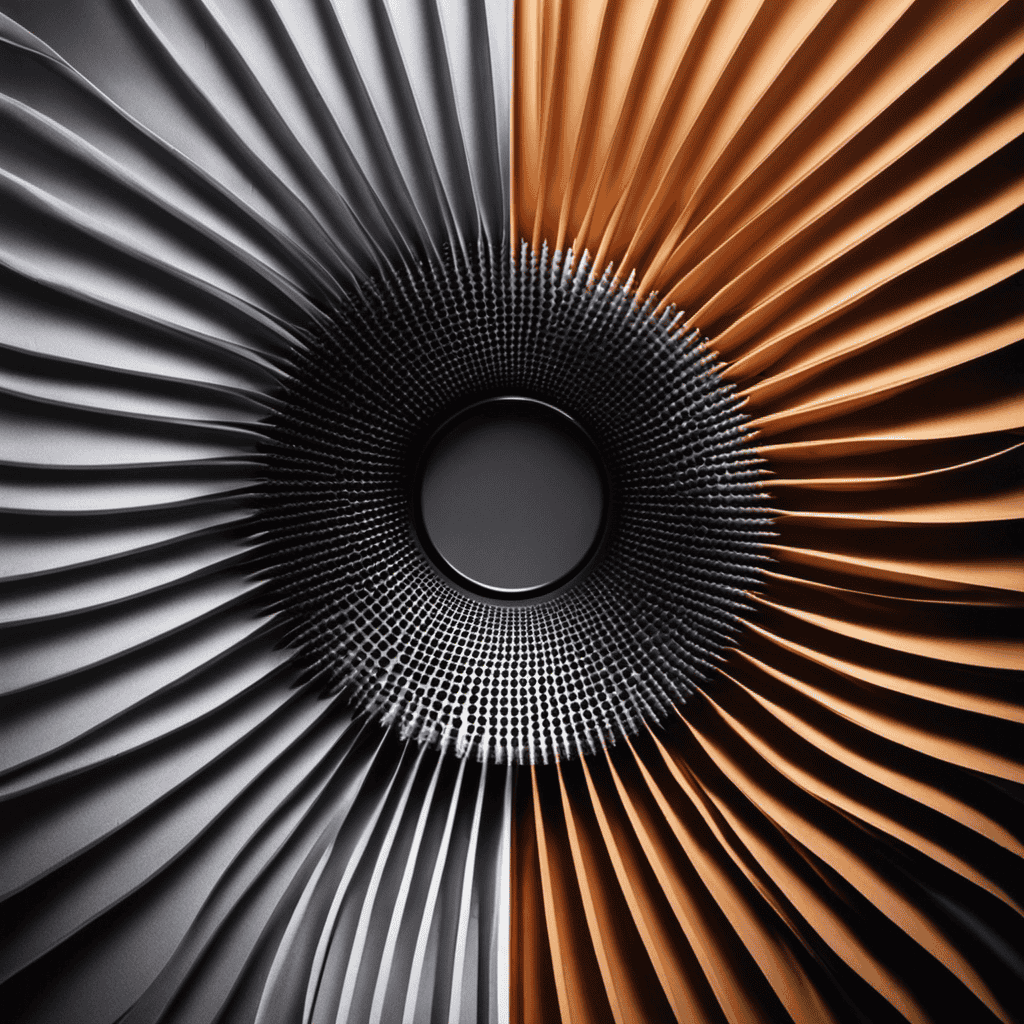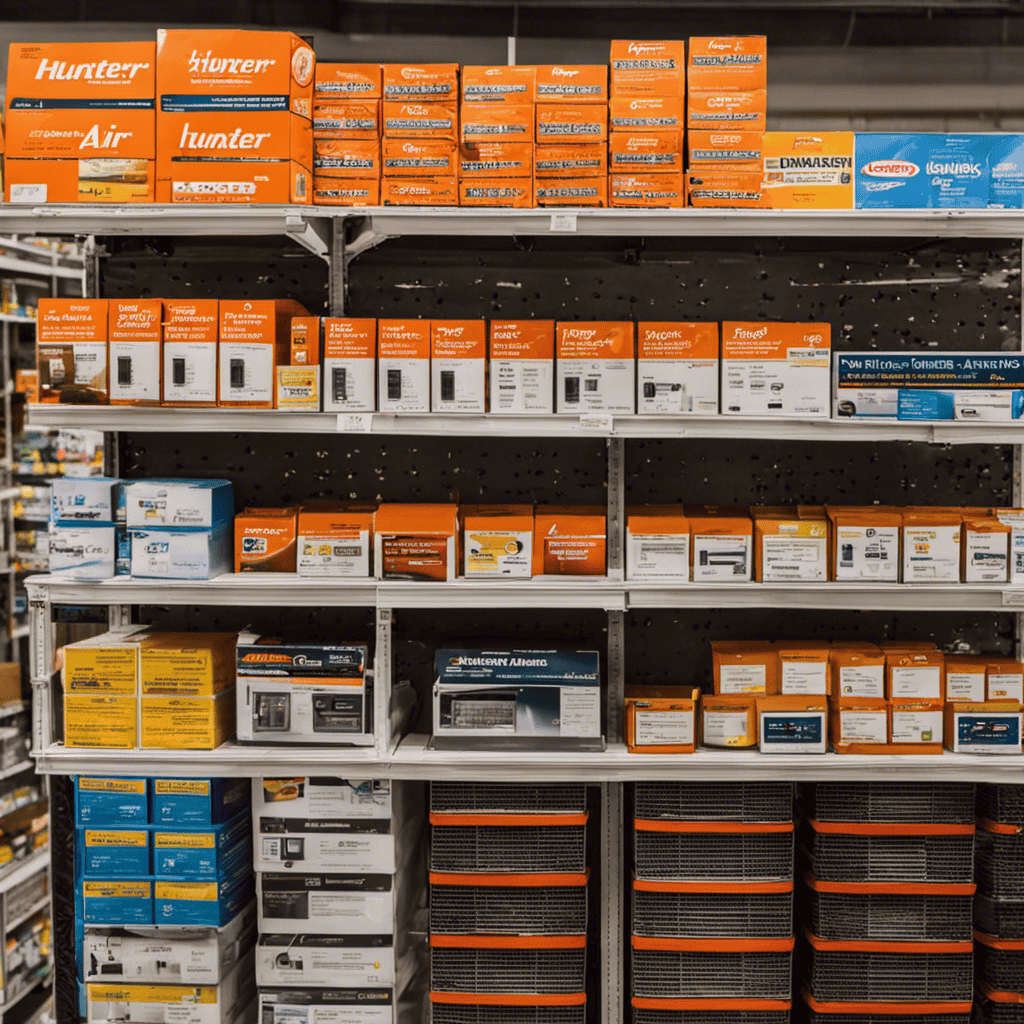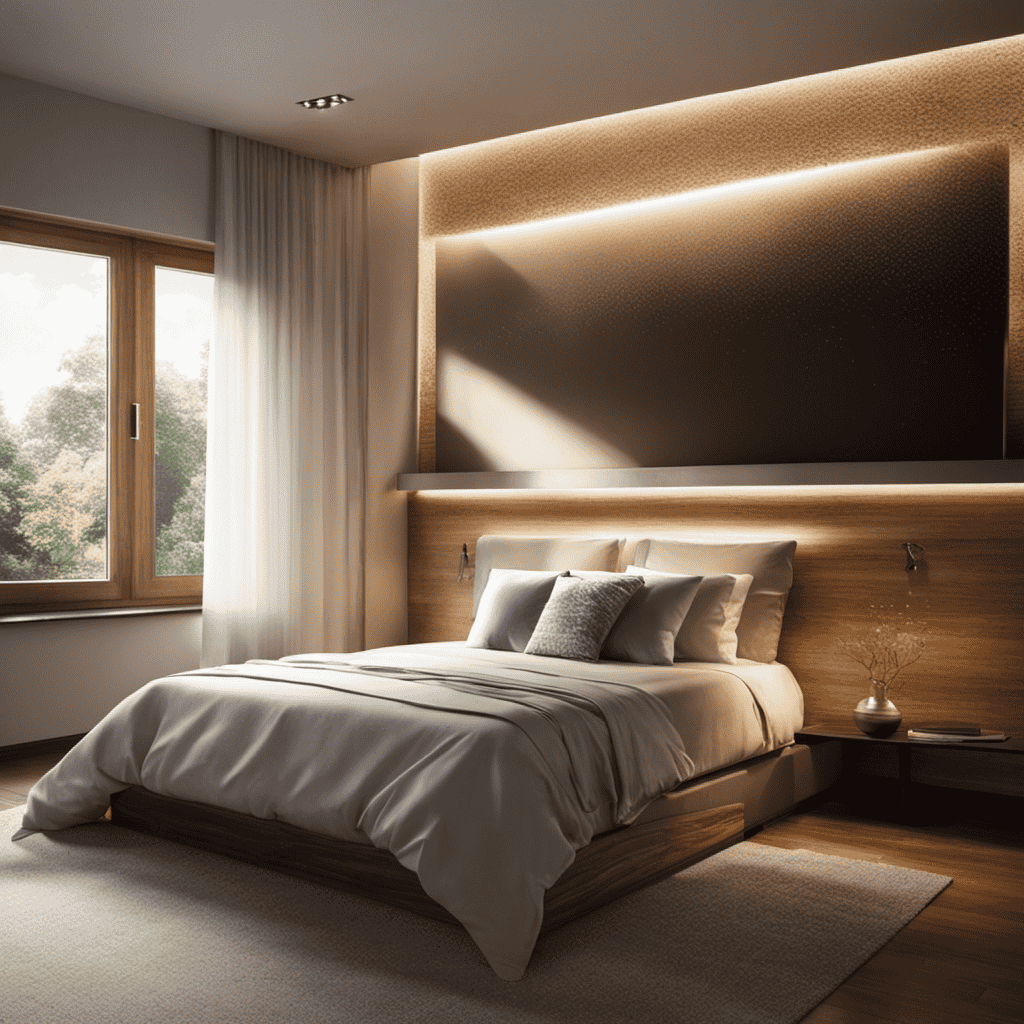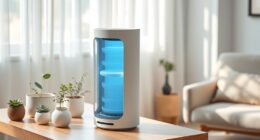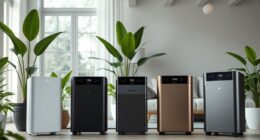I’ve always been curious about the purpose of an air purifier. It’s something you often hear mentioned but seldom take the time to truly understand.
Well, let me tell you, after doing some research, I’ve come to realize just how important these devices are for improving indoor air quality.
In this article, we’ll explore the many benefits of using an air purifier, how they work to remove different types of pollutants, and the health effects of poor indoor air quality.
So, let’s dive in and discover why investing in an air purifier might just be the best decision you make for your well-being.
Key Takeaways
- Air purifiers improve indoor air quality by removing allergens, pollutants, and unpleasant odors.
- They provide relief for allergies and reduce allergy symptoms.
- Air purifiers help control indoor pollution and reduce the spread of viruses and bacteria.
- By removing harmful gases and chemicals, air purifiers contribute to cleaner and safer air.
Benefits of Using an Air Purifier
Using an air purifier can greatly improve the air quality in your home. Air purifiers are specifically designed to remove harmful particles from the air, making it safer and healthier to breathe.
One of the main benefits of using an air purifier is its ability to provide relief for allergies. These devices are equipped with filters that can capture allergens such as pollen, dust mites, and pet dander, reducing the chances of an allergic reaction.
Additionally, air purifiers are effective in controlling pollution indoors. They can remove pollutants like smoke, volatile organic compounds (VOCs), and odors, creating a cleaner and fresher environment.
With the use of an air purifier, you can enjoy cleaner air and experience fewer allergy symptoms.
Transitioning into the next section, let’s explore how air purifiers improve indoor air quality.
How Air Purifiers Improve Indoor Air Quality
By trapping and removing harmful particles, air purifiers can greatly enhance the quality of indoor air. They are effective in improving indoor air quality by:
-
Removing allergens: Air purifiers can capture and eliminate common allergens such as dust mites, pet dander, and pollen, reducing the risk of allergic reactions and respiratory issues.
-
Filtering out airborne pollutants: Air purifiers can effectively remove pollutants like smoke, smog, and volatile organic compounds (VOCs), which can have detrimental effects on our health.
-
Eliminating odors: Air purifiers equipped with activated carbon filters can help eliminate unpleasant odors caused by cooking, pets, or chemicals, making the indoor environment more pleasant.
-
Reducing the spread of viruses and bacteria: Air purifiers with HEPA filters can capture and trap airborne viruses and bacteria, reducing the risk of illnesses and improving overall well-being.
Improving indoor air quality is crucial for maintaining a healthy living environment. Air purifiers play a vital role in achieving this goal, ensuring that we breathe cleaner and safer air.
Now, let’s explore the different types of air pollutants removed by air purifiers.
Different Types of Air Pollutants Removed by Air Purifiers
Different types of air pollutants can be effectively removed by air purifiers, improving indoor air quality.
Air purifiers are not only beneficial for removing indoor pollutants such as dust, allergens, and pet dander, but they can also help in reducing outdoor pollution and eliminating chemical fumes.
Outdoor pollution, such as particulate matter and smog, can enter indoor spaces and affect the air quality. Air purifiers equipped with HEPA filters can effectively trap these pollutants and prevent them from circulating in the indoor environment.
Additionally, air purifiers with activated carbon filters are highly effective in removing chemical fumes and odors from the air. These filters have a large surface area that can absorb harmful gases and chemicals, improving the overall air quality and creating a healthier living environment.
Health Effects of Poor Indoor Air Quality
When it comes to the health risks of pollution, it’s important to consider the sources of indoor air pollution.
Indoor air pollution can come from a variety of sources, including tobacco smoke, household cleaning products, and building materials.
Understanding these sources can help us better understand the potential health effects and take appropriate measures to reduce exposure.
Health Risks of Pollution
Air pollution can pose significant health risks that can be mitigated with the use of an air purifier. Breathing polluted air can lead to various health problems, including respiratory issues, cardiovascular diseases, and even cancer.
Here are four specific health risks associated with pollution:
-
Respiratory problems: High levels of pollutants in the air can irritate the respiratory system, leading to symptoms such as coughing, wheezing, and shortness of breath.
-
Cardiovascular diseases: Air pollution has been linked to an increased risk of heart attacks, strokes, and other cardiovascular problems. Fine particles in the air can enter the bloodstream and cause inflammation, leading to the development of these diseases.
-
Allergies and asthma: Pollutants like pollen, mold spores, and dust mites can trigger allergies and exacerbate asthma symptoms. An air purifier can help remove these allergens from the air, reducing the risk of allergic reactions and asthma attacks.
-
Cancer: Certain air pollutants, such as benzene, formaldehyde, and asbestos, are known carcinogens. Prolonged exposure to these substances can increase the risk of developing lung cancer and other types of cancer.
Indoor Air Pollution Sources
To reduce indoor air pollution, you can take simple steps like regularly cleaning your home, avoiding smoking indoors, and properly ventilating areas where pollutants may accumulate. However, sometimes these measures may not be sufficient to completely eliminate pollutants from the air.
This is where air purifiers come in. Air purifiers are devices designed to remove contaminants from the air, improving indoor air quality. They are not only useful in homes but can also be beneficial in cars and for babies.
Air purifiers for cars help eliminate pollutants such as exhaust fumes, dust, and allergens that can enter the vehicle from outside. On the other hand, air purifiers for babies are specifically designed to create a safe and healthy environment for infants by removing harmful particles such as dust, pet dander, and volatile organic compounds.
Investing in an air purifier can greatly contribute to the overall well-being of your family by ensuring clean and fresh air in your home, car, and baby’s nursery.
Common Sources of Indoor Air Pollution
One of the most common sources of indoor air pollution is cigarette smoke. It releases harmful chemicals and toxins into the air, posing a significant threat to our health.
However, there are other sources of indoor air pollution that we should be aware of:
-
Household cleaning products: Many cleaning products contain volatile organic compounds (VOCs) that can contribute to indoor air pollution.
-
Mold and mildew: Moisture and humidity can lead to the growth of mold and mildew, which release spores into the air and can cause respiratory issues.
-
Pet dander: Pets can shed dander, which is a common allergen and can lead to respiratory problems, especially for people with allergies.
-
Pollen: Pollen from plants and trees can enter our homes through open windows or on our clothes and shoes, causing allergic reactions.
Air purifiers can help alleviate these indoor air pollution sources, providing clean and fresh air for everyone, including newborns and seniors.
Now, let’s explore how air purifiers work.
How Air Purifiers Work
If you’re curious about how these devices work, let’s take a closer look at their mechanisms.
Air purifiers function by using a filtration process to remove harmful particles from the air. The first step is the pre-filter, which captures larger particles like dust and pet hair. Then, the air passes through a HEPA (High-Efficiency Particulate Air) filter, which traps smaller particles such as pollen, mold spores, and bacteria. Some air purifiers also employ activated carbon filters to eliminate odors and chemicals.
Regular air purifier maintenance is crucial to ensure optimal performance. This includes cleaning or replacing the filters according to the manufacturer’s instructions. It’s also important to clean the unit itself and keep it free from dust buildup.
Understanding how air purifiers work and maintaining them properly can greatly improve indoor air quality.
Now, let’s explore how to choose the right air purifier for your needs.
Choosing the Right Air Purifier for Your Needs
When it comes to choosing the right air purifier for your needs, there are several key points that should be considered.
First, you need to determine the size and coverage that you require, as this will determine the effectiveness of the purifier in your space.
Second, it is important to consider the filtration technology options available, such as HEPA filters or activated carbon filters, to ensure that the purifier is capable of removing the specific pollutants you are concerned about.
Lastly, factors like noise levels and maintenance should be taken into account to ensure that the purifier is convenient and easy to use in your daily life.
Size and Coverage
To determine the right air purifier for you, consider the size of the room and the coverage area it can handle. Air purifiers come in different sizes, and it’s important to choose one that is appropriate for the space you want to purify. Here are four factors to consider when determining the size and coverage capacity of an air purifier:
-
Room size: Measure the square footage of the room to determine the appropriate size of the air purifier. A larger room will require a purifier with a higher coverage capacity.
-
Air changes per hour: Consider how many times you want the air in the room to be completely filtered. For optimal results, choose an air purifier that can provide at least 4-6 air changes per hour.
-
Filter lifespan: Check the lifespan of the filters used in the air purifier. Ensure that they can effectively clean the room for an extended period without requiring frequent replacements.
-
Noise level: Some air purifiers can be noisy, especially on higher fan speeds. Take into account the noise level and choose a purifier that won’t disrupt your comfort.
Considering these factors will help you select an air purifier that is suitable for your needs and effectively purifies the air in your space. Now, let’s explore the different filtration technology options available.
Filtration Technology Options
One option for filtration technology is a HEPA filter. HEPA stands for High Efficiency Particulate Air, and these filters are highly effective at capturing small particles like dust, pollen, and pet dander. They are designed to remove 99.97% of airborne particles that are 0.3 microns or larger.
This technology has advanced significantly over the years, with improvements in filter materials and designs. HEPA filters are now capable of capturing even smaller particles, including bacteria, viruses, and mold spores. This is crucial in addressing the impact of air pollution on respiratory health, as these tiny particles can easily enter our lungs and cause respiratory problems.
Noise Levels and Maintenance
Maintaining your filtration system is essential to ensure optimal performance and minimize noise levels. Here are four key factors to consider when it comes to noise reduction and filter replacement:
-
Regular Filter Cleaning: Dust and debris can accumulate on the filters over time, causing airflow restriction and increased noise. Cleaning or replacing the filters regularly can help maintain proper airflow and reduce noise levels.
-
Proper Filter Placement: Ensuring that the filters are properly installed and securely in place can prevent air leaks and reduce vibrations, which can contribute to noise.
-
Noise Reduction Features: Some air purifiers come with noise reduction features such as adjustable fan speeds or sleep modes, which can help decrease noise levels during nighttime or quiet hours.
-
Filter Replacement Schedule: Following the manufacturer’s recommended filter replacement schedule is crucial. Clogged or dirty filters can obstruct airflow, leading to increased noise levels and reduced performance.
By considering these factors and properly maintaining your air purifier, you can enjoy cleaner air with minimal noise.
Now, let’s delve into the factors to consider when buying an air purifier.
Factors to Consider When Buying an Air Purifier
When considering buying an air purifier, it’s important to think about factors like the size of the room and the type of filtration system. These factors can greatly impact the effectiveness of the air purifier in removing pollutants and improving indoor air quality. To help you make an informed decision, I have prepared a table below that outlines some important factors to consider when buying an air purifier, as well as some top brands to consider.
| Factors to Consider | Top Brands to Consider |
|---|---|
| Room Size | Honeywell |
| Filtration System | Blueair |
| Noise Level | Coway |
| Energy Efficiency | Levoit |
| Additional Features | Alen |
Tips for Maintaining and Cleaning Your Air Purifier
To keep your air purifier running efficiently, you should regularly clean and replace the filters as recommended by the manufacturer. Proper maintenance is crucial for ensuring that your air purifier continues to effectively remove pollutants from the air in your home. Here are some cleaning techniques and a maintenance schedule to follow:
- Vacuum the exterior of the air purifier to remove dust and debris.
- Clean the pre-filter every month to prevent it from clogging.
- Replace the HEPA filter every 6 to 12 months, depending on usage.
- Clean the sensor or indicator lights regularly to ensure accurate readings.
By following these cleaning techniques and adhering to a maintenance schedule, you can prolong the life of your air purifier and maintain its optimal performance.
With a properly maintained air purifier, you can breathe cleaner air and reduce the risk of allergies and asthma symptoms.
Transition: Now let’s explore how air purifiers can provide relief for allergies and asthma.
Air Purifiers for Allergies and Asthma Relief
If you suffer from allergies or asthma, using an air purifier can greatly alleviate your symptoms. Air purifiers are designed to remove pollutants from the air, including dust and pollen, which are common triggers for allergies and asthma attacks. These devices work by drawing in air and passing it through filters that capture and trap particles, preventing them from circulating in the room.
When it comes to dust removal, air purifiers with HEPA filters are highly effective. HEPA filters can capture particles as small as 0.3 microns, effectively removing dust mites, pet dander, and other microscopic allergens. For pollen allergies, look for air purifiers with activated carbon filters, as they can help remove pollen particles from the air.
Transitioning into the next section on air purifiers for pet owners, it’s important to note that these devices can also help remove pet dander and odors, providing relief for those with allergies to furry friends.
Air Purifiers for Pet Owners
As a pet owner, finding the right air purifier is crucial for maintaining a clean and healthy environment for both myself and my furry friend. Pet-friendly air purification systems are designed to effectively remove pet dander, hair, and odors from the air, reducing allergens and improving indoor air quality.
When choosing the right purifier, factors such as the size of the room, the type of filter, and the noise level should be considered to ensure maximum benefits for pet owners.
Pet-Friendly Air Purification
A pet-friendly air purifier can help reduce allergens and odors in your home. As a pet owner, I understand the importance of creating a clean and healthy environment for both myself and my furry friends. Here are four reasons why a pet-friendly air purifier is a great investment:
-
Advanced Filtration Technology: Pet-friendly air purifiers are specially designed to capture pet dander, hair, and other allergens that can trigger allergies and respiratory issues.
-
Odor Elimination: These air purifiers have activated carbon filters that effectively remove pet odors, leaving your home smelling fresh and clean.
-
Allergy Relief: By reducing allergens in the air, a pet-friendly air purifier can help alleviate allergy symptoms such as sneezing, coughing, and itchy eyes.
-
Improved Air Quality: Regular use of an air purifier can improve overall indoor air quality, creating a healthier and more comfortable living environment for both you and your pets.
Investing in a pet-friendly air purifier is a simple and effective way to ensure the well-being of your pets and the entire household.
Benefits for Pet Owners
Investing in a pet-friendly air purifier provides numerous benefits for pet owners, such as improved air quality and allergy relief. As a pet owner myself, I understand the struggles of dealing with pet hair and dander in the home. That’s why I decided to invest in an air purifier specifically designed to tackle these issues. Not only does it effectively remove pet hair from the air, but it also helps control pet dander, which is a common allergen for many people. The table below highlights some key features of a pet-friendly air purifier:
| Benefit | Description |
|---|---|
| Improved Air Quality | Removes pet hair and dander from the air, reducing allergens and irritants. |
| Allergy Relief | Helps alleviate symptoms for those with pet allergies by reducing airborne pet allergens. |
| Odor Elimination | Eliminates pet odors, keeping your home smelling fresh and clean. |
Overall, investing in a pet-friendly air purifier is a wise decision for pet owners looking to improve their indoor air quality and provide relief from pet-related allergies.
Choosing the Right Purifier
When it comes to choosing the right air purifier, there are several factors to consider. First, you need to look at the size of the room where you will be using it. Different air purifiers have different coverage areas, so it’s important to choose one that can effectively clean the air in your space.
Second, consider the type of filter the purifier uses. HEPA filters are highly effective at capturing small particles and allergens, while activated carbon filters are great for removing odors and chemicals.
Third, think about the noise level of the purifier. Some models are quieter than others, so if you plan on using it in your bedroom or office, you may want to choose one with a lower noise level.
Lastly, consider the cost of the purifier and any ongoing maintenance expenses, such as filter replacements. Comparing prices and weighing the features against the cost will help you make an informed decision.
Now that we’ve discussed the important factors to consider when choosing an air purifier, let’s move on to the next section where we will explore air purifiers specifically designed for smokers and odor elimination.
Air Purifiers for Smokers and Odor Elimination
If you’re a smoker or dealing with unpleasant odors, an air purifier can help eliminate those smells. Smoke elimination and odor neutralization are two key benefits of using an air purifier in such situations.
Research has shown that air purifiers equipped with activated carbon filters are particularly effective at removing smoke particles and neutralizing odors. These filters contain millions of tiny pores that trap smoke particles and other volatile organic compounds, preventing them from recirculating in the air. Additionally, some air purifiers also use ozone generators or photocatalytic oxidation to break down odor-causing molecules.
By utilizing these technologies, air purifiers can significantly improve indoor air quality and create a more pleasant living environment for smokers and non-smokers alike.
Transitioning into the subsequent section about air purifiers for mold and mildew prevention, it’s important to note that these devices can also play a crucial role in maintaining a healthy home environment.
Air Purifiers for Mold and Mildew Prevention
When it comes to preventing mold and mildew, air purifiers can play a crucial role. They help remove airborne mold spores and reduce overall moisture in the air. This creates an environment that is less conducive to mold growth.
In terms of the best purifier options, there are a few key factors to consider. These include the unit’s filtration capabilities, coverage area, and additional features like a dehumidifier or UV-C light.
Mold Prevention Benefits
Using an air purifier can help prevent mold from spreading in your home. Mold prevention techniques are crucial for maintaining a healthy indoor environment.
Here are four reasons why investing in an air purifier is important for mold prevention and maintaining good indoor air quality:
-
Filtration: Air purifiers are equipped with filters that capture mold spores and prevent them from circulating in the air. This helps to reduce the chances of mold growth and spread.
-
Improved Air Quality: By removing mold spores and other pollutants from the air, air purifiers contribute to better indoor air quality. This is essential for preventing respiratory issues and allergic reactions caused by mold exposure.
-
Drying Effect: Some air purifiers come with built-in dehumidifiers that help to reduce excess moisture in the air. Since mold thrives in damp environments, reducing humidity levels can significantly inhibit its growth.
-
Continuous Operation: Air purifiers can run continuously, ensuring a consistent and efficient removal of mold spores. This constant filtration helps to maintain a mold-free environment and prevents the spread of mold spores throughout your home.
Investing in an air purifier is an effective and proactive step in preventing mold growth and maintaining a healthy indoor environment. By improving air quality and reducing excess moisture, air purifiers play a vital role in mold prevention.
Best Purifier Options?
For the best options, you should consider the size of the room and the specific features you need.
When it comes to finding the best purifier options, it’s important to look for top-rated air purifiers that meet your specific needs.
One of the key factors to consider is the size of the room in which you plan to use the purifier. A purifier that is too small may not effectively clean the air, while one that is too large may be unnecessary and expensive.
Additionally, you should consider the specific features you need. Some purifiers offer additional features such as HEPA filters, UV-C lights, or activated carbon filters, which can help remove different types of pollutants from the air.
Air Purifiers for a Healthier Sleep Environment
To create a healthier sleep environment, you’ll want to consider using an air purifier. Here are four reasons why air purifiers are beneficial for better sleep and for children’s bedrooms:
-
Allergen Removal: Air purifiers can remove common allergens such as dust mites, pollen, and pet dander from the air, reducing the risk of allergic reactions and improving sleep quality.
-
Odor Elimination: Air purifiers with activated carbon filters can effectively remove unpleasant odors, creating a fresh and clean atmosphere in the bedroom, which can promote better sleep.
-
Air Circulation: Air purifiers help to circulate and filter the air, removing particles that may disturb sleep, such as airborne pollutants and irritants.
-
Noise Reduction: Some air purifiers are designed with quiet operation, providing white noise that can help mask other disruptive sounds and promote a more peaceful sleep environment.
By using an air purifier in your bedroom, you can create a clean, allergen-free space that promotes better sleep for both adults and children.
Transitioning into the subsequent section about ‘air purifiers for offices and commercial spaces’, air purifiers can also provide similar benefits in these environments.
Air Purifiers for Offices and Commercial Spaces
If you work in an office or commercial space, you’ll want to consider how an air purifier can improve the air quality. Air purifiers are especially beneficial for large spaces like offices and commercial areas, where there are often many people and potential sources of air pollution. These devices work by capturing and removing harmful particles and pollutants from the air, ensuring that you and your colleagues breathe in clean and healthy air throughout the day.
In addition to offices and commercial spaces, air purifiers are also commonly used in hospitals and healthcare facilities. These environments require the highest level of air quality to protect the health and well-being of patients and healthcare professionals. Air purifiers in hospitals and healthcare facilities are designed to effectively remove airborne bacteria, viruses, and other contaminants, creating a safer and cleaner environment for everyone.
Investing in an air purifier for your office or commercial space can have numerous benefits, including improved air quality, reduced allergies and respiratory issues, and increased productivity. Similarly, air purifiers play a crucial role in maintaining a clean and healthy environment in hospitals and healthcare facilities, where air quality is of utmost importance.
Frequently Asked Questions
Can Air Purifiers Help With Reducing Symptoms of Respiratory Illnesses Such as Allergies and Asthma?
Air purifiers can be beneficial for reducing symptoms of respiratory illnesses like allergies and asthma. They help improve indoor air quality by removing allergens and pollutants, creating a healthier environment for those with respiratory conditions.
Are Air Purifiers Effective in Eliminating Odors From Smoke and Pet Dander?
Air purifiers are effective in eliminating smoke odors and reducing pet dander. They capture and remove airborne particles, such as smoke particles and pet allergens, improving indoor air quality and reducing respiratory symptoms.
What Are the Benefits of Using an Air Purifier in an Office or Commercial Space?
Using an air purifier in an office or commercial space can provide numerous benefits. They can help reduce airborne viruses, improve air quality, and create a healthier environment for employees and customers.
Can Air Purifiers Prevent the Growth of Mold and Mildew in Indoor Environments?
Air purifiers help prevent the growth of mold and mildew in indoor environments by filtering out allergens, pollutants, and moisture. They improve indoor air quality, creating a healthier and more comfortable living space.
How Can Air Purifiers Contribute to Creating a Healthier Sleep Environment?
Air purifiers can greatly impact overall indoor air quality by effectively reducing airborne pollutants. They create a healthier sleep environment by removing allergens, dust, and other irritants, promoting better breathing and reducing the risk of respiratory issues.
Conclusion
In conclusion, using an air purifier is essential for improving indoor air quality and safeguarding our health. By removing various types of pollutants, such as dust, pollen, and pet dander, air purifiers create a clean and fresh environment.
Just like how a lighthouse guides ships through treacherous waters, an air purifier acts as a beacon of protection, clearing the path for healthier living.
With the rising concerns of air pollution and its detrimental effects, investing in an air purifier is a wise choice for a healthier future.
